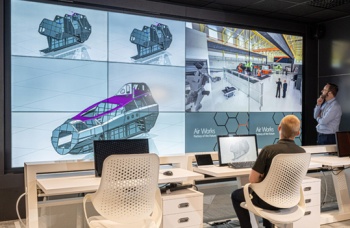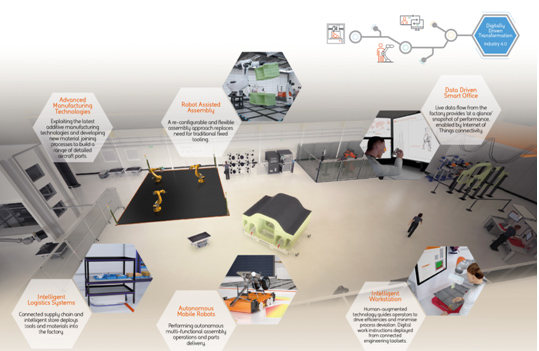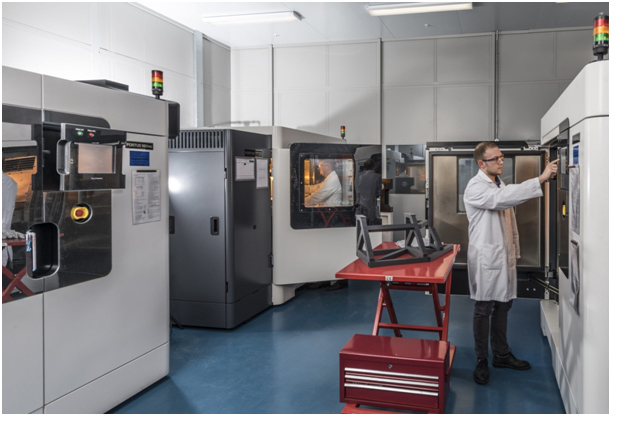
At BAE Systems, a new intelligent, smart factory is now set to increase productivity and revolutionize combat aircraft production in the UK. This first-of-its-kind industry 4.0 factory is applying game-changing digital technologies to advance manufacturing on the UK’s next-generation combat aircraft system, Tempest.
Welcome to the BAE Systems Factory of the Future, a place where revolutionary technologies meet a digitally-minded engineering workforce to create incredible solutions to the problems of tomorrow. Working with experts from the firm’s strategic university research network to specialists in data, robotics, connectivity and 3D printing technology, the BAE manufacturing team designed a fully connected, digital factory.
More than 40 blue chip and SME companies and academic institutions are collaborating on the project, driving the very best of UK innovation into the facility. Drawing on Industry 4.0 technologies, BAE created this connected, intelligent hub at Warton site, in the North West of England, to demonstrate how military aircraft could be built in the future. The new facility is the result of a multi-million-pound investment and serves as an experimental hub equipped with state of the art technology to enable engineers to research, invest and test new technologies, build new capabilities and harness transformative ways of working.
Bringing together advanced manufacturing technologies, the factory will transform engineering processes. Automated robots, virtual and augmented reality will increase speed, precision and efficiencies, as well as reduce the costs associated with the manufacture of complex military aircraft structures.
 A connected intelligent factory for military aircraft technologies
A connected intelligent factory for military aircraft technologies
FFF, the flexible factory of the future
BAE Systems envisage a future environment for tomorrow’s air forces which is complex and rapidly evolving. The firm intends to be able to reduce or grow manufacturing capabilities quickly based on demand, cost-effectively and flexibly. This means rapidly switching from building a new fighter aircraft one day, to small volume unmanned vehicles the next. The Factory has been designed to be more than just the sum of its parts. The connectivity between the machines, the robots and the human operators creates a new and revolutionary approach to manufacturing. A connected series of systems, enabled by the Internet of Things, for next-generation manufacturing.
The factory demonstrates a new approach to the way humans and machines can operate together. Cobotic and flexible robotic technologies remove the need for heavy, fixed, long-lead tooling and can quickly switch from the manufacture of one item or platform to another. Intelligent machines and off-the-shelf robotic technology from the automotive industry have been modified to operate at the precise tolerances required for military aircraft, which can be less than a third the width of a human hair.
Such technology drives greater productivity by allowing operators to focus on more highly-skilled and strategic tasks and production managers to oversee operations from a fully digitized, virtual office.
The new facility underpins efforts of the UK-led Tempest program to meet the UK’s ambition to remain at the forefront of the Combat Air sector by delivering more cost-effectively and in half the time of previous programs.
“We’ve collaborated with the best of UK industry and academia to develop a cutting-edge facility that combines current and emerging technologies, ensuring the UK remains at the forefront of combat air technology development,” said Dave Holmes, Manufacturing Director for BAE Systems Ai. “Driving our manufacturing capabilities forward as we prepare for the fourth Industrial Revolution, will sustain and develop critical skillsets and ensure we can continue to deliver military capability to address future threats, whilst improving productivity and delivering value for money for our customers.”
Enter 3D printing
Technologies inside the factory are already delivering benefits. The intelligent workstation, developed in collaboration with The University of Sheffield’s Advanced Manufacturing Research Centre (AMRC) and Fairfield Control Systems, is in use on the Typhoon production line. It uses a system that recognizes operators and automatically delivers tailored instructions using ‘pick by light’ technologies. In addition, additive manufacturing technologies are being used in the production of Typhoon aircraft parts and assemblies.
Like several military and aerospace leaders, BAE Systems have been using 3D printing for decades and additive manufactured parts are being flown on Hawk and Typhoon aircraft today. Recently the company acquired the fourth Stratasys Fortus 900mc system, which is Stratasys’ largest FDM 3D printer and offers packages and materials tailored – and certified – for aerospace part production. Inside the Factory, BAE is now beginning to build large structural components.
 The four Stratasys Fortus 900 systems.
The four Stratasys Fortus 900 systems.
“Our Factory of the Future program is all about driving the future of fighter aircraft production with disruptive technologies and we’re working closely with our suppliers and the wider industry to meet the challenges the UK Government has set out to us,” stated Greg Flanagan, Additive Manufacturing Operations Lead, BAE Systems Air. “Stratasys FDM additive manufacturing plays an important role in this initiative, as it helps us meet our overall company objectives to reduce costs and time-to-market.”
BAE Systems has now taken a serious stand in embracing advanced manufacturing technologies and put its UK suppliers on notice of a major shake-up, by saying it expects to make far greater use of innovative manufacturing techniques in its next-generation combat aircraft. The British firm has reportedly set targets for 30 percent of the components of the Tempest fighter jet to be made through 3D printing, and for 50 percent of the aircraft to be put together by robots on the UK defense group’s assembly line.


